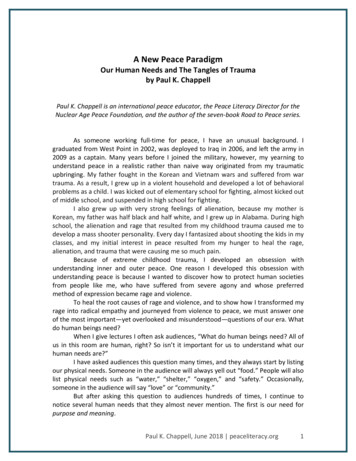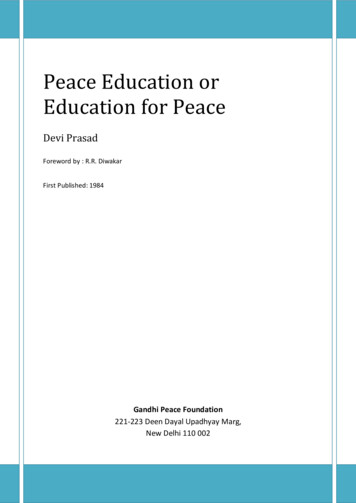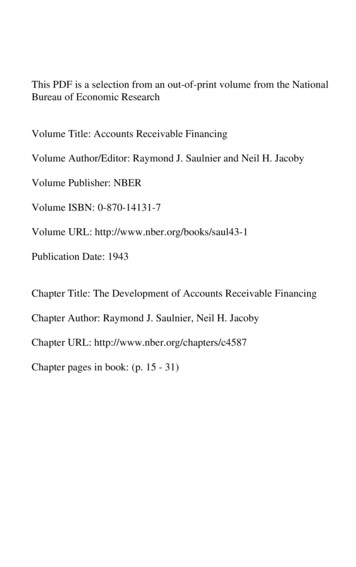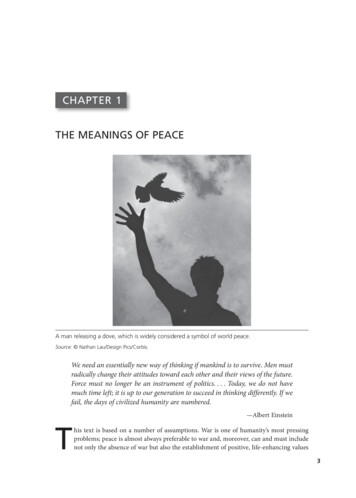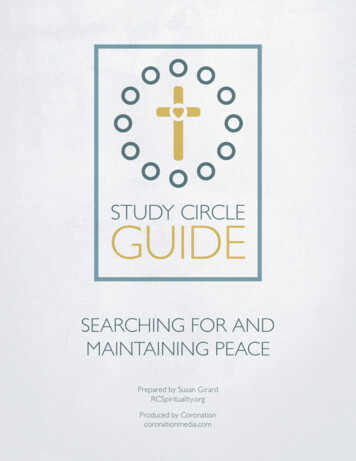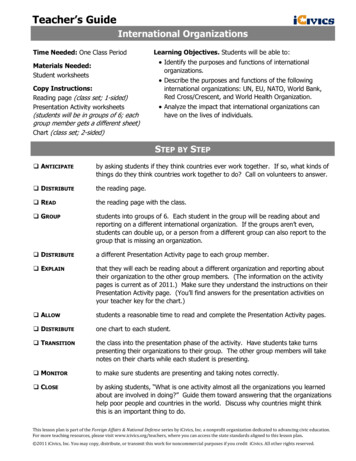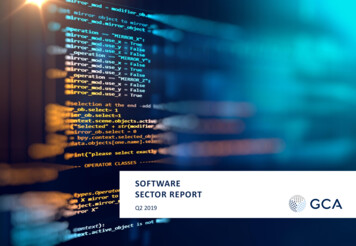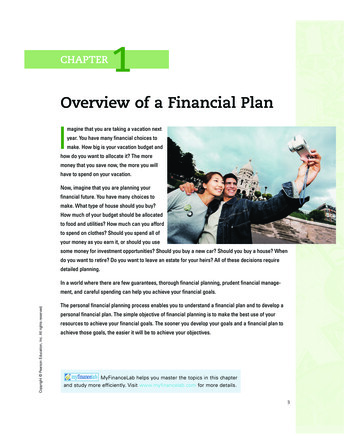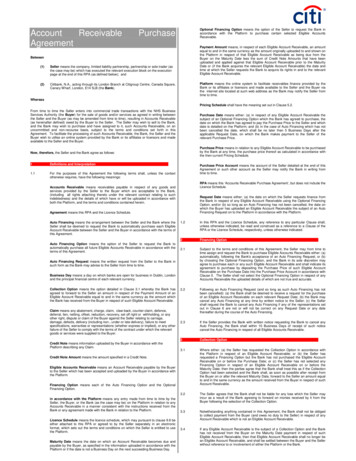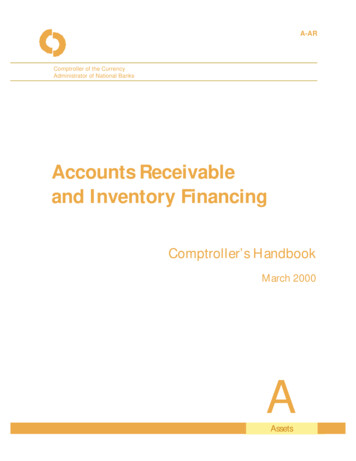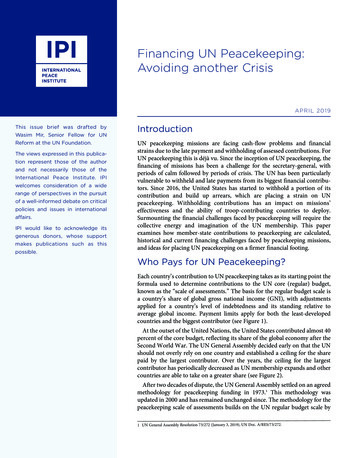
Transcription
Financing UN Peacekeeping:Avoiding another CrisisAPRIL 2019This issue brief was drafted byIntroductionWasim Mir, Senior Fellow for UNReform at the UN Foundation.The views expressed in this publication represent those of the authorand not necessarily those of theInternational Peace Institute. IPIwelcomes consideration of a widerange of perspectives in the pursuitof a well-informed debate on criticalpolicies and issues in internationalaffairs.IPI would like to acknowledge itsgenerous donors, whose supportmakes publications such as thispossible.UN peacekeeping missions are facing cash-flow problems and financialstrains due to the late payment and withholding of assessed contributions. ForUN peacekeeping this is déjà vu. Since the inception of UN peacekeeping, thefinancing of missions has been a challenge for the secretary-general, withperiods of calm followed by periods of crisis. The UN has been particularlyvulnerable to withheld and late payments from its biggest financial contributors. Since 2016, the United States has started to withhold a portion of itscontribution and build up arrears, which are placing a strain on UNpeacekeeping. Withholding contributions has an impact on missions’effectiveness and the ability of troop-contributing countries to deploy.Surmounting the financial challenges faced by peacekeeping will require thecollective energy and imagination of the UN membership. This paperexamines how member-state contributions to peacekeeping are calculated,historical and current financing challenges faced by peacekeeping missions,and ideas for placing UN peacekeeping on a firmer financial footing.Who Pays for UN Peacekeeping?Each country’s contribution to UN peacekeeping takes as its starting point theformula used to determine contributions to the UN core (regular) budget,known as the “scale of assessments.” The basis for the regular budget scale isa country’s share of global gross national income (GNI), with adjustmentsapplied for a country’s level of indebtedness and its standing relative toaverage global income. Payment limits apply for both the least-developedcountries and the biggest contributor (see Figure 1).At the outset of the United Nations, the United States contributed almost 40percent of the core budget, reflecting its share of the global economy after theSecond World War. The UN General Assembly decided early on that the UNshould not overly rely on one country and established a ceiling for the sharepaid by the largest contributor. Over the years, the ceiling for the largestcontributor has periodically decreased as UN membership expands and othercountries are able to take on a greater share (see Figure 2).After two decades of dispute, the UN General Assembly settled on an agreedmethodology for peacekeeping funding in 1973.1 This methodology wasupdated in 2000 and has remained unchanged since. The methodology for thepeacekeeping scale of assessments builds on the UN regular budget scale by1 UN General Assembly Resolution 73/272 (January 3, 2019), UN Doc. A/RES/73/272.
2ISSUE BRIEFFigure 1. Methodology for determining regular budget scale of assessmentsapplying additional adjustments to determine eachcountry’s share of the peacekeeping budget.2Countries are divided into ten levels based ontheir per capita income (see Table 1). Countrieswith per capita income below twice the worldaverage are placed in levels D to I and receivediscounts on a sliding scale based on their relativeper capita income. Most countries with incometwice the world average contribute at the same rateto peacekeeping as to the regular budget, althougha small number of wealthy countries (e.g. Brunei,Saudi Arabia, and the United Arab Emirates)receive small discounts. The permanent membersof the security council form a separate level inrecognition of their decision-making responsibilities for peacekeeping and pay an increased share(above their regular budget rate) equivalent to thediscounts received by other countries.Figure 2. Ceiling for largest contributor to UN regular budget2 UN General Assembly Resolution 55/235 (January 30, 2001), UN Doc. A/RES/55/235.
Financing UN Peacekeeping: Avoiding another Crisis3Table 1. Ten levels of peacekeeping contributors3LevelCriteriaDiscount LevelAPermanent members of the Security CouncilPremiumBCountries with per capita income more than 2 times the world average0CCountries with per capita income more than 2 times the world averagebut still in receipt of discounts7.5DCountries with per capita income less than 2 times the world average20ECountries with per capita income less than 1.8 times the world average40FCountries with per capita income less than 1.6 times the world average60GCountries with per capita income less than 1.4 times the world average70HCountries with per capita income less than 1.2 times the world average80ICountries with per capita income less than the world average80JLeast-developed countries90The combination of the UN regular budget scaleand the additional discounts applied to UNpeacekeeping can be dramatic (see Figure 3). Manycountries pay vastly different amounts to the UNregular and peacekeeping budgets even when thesize of their economy has been factored in. India’sshare of the regular budget is five times as big as itsshare of the peacekeeping budget, and San Marino(population 33,000) pays three times as much toUN peacekeeping as Bangladesh (population 162Figure 3. Share of regular and peacekeeping budget assessments for ten biggest economies3 UN General Assembly Resolution 73/272 (January 3, 2019), UN Doc. A/RES/73/272.
4ISSUE BRIEFmillion). The share of the five permanent membersof the council, on the other hand, is 27 percentmore than their share of the regular budget.tion as a matter of principle, arguing that authorityfor mandating peacekeeping missions rested solelywith the Security Council.Both the regular budget and the peacekeepingbudget scales are scheduled for renegotiation everythree years by the General Assembly, but becausethe scales are a classic zero-sum negotiation—ifone country pays less, another country must paymore—UN member states have consistentlystruggled to agree on significant changes. Themethodology for the peacekeeping scale has onlybeen significantly adjusted once in the last fortyyears. Despite the efforts of some delegations, themost recent negotiations on both the peacekeepingand the regular budgets, completed in December2018, maintained the status quo.The UN Operation in the Congo (ONUC),established in 1960, faced even bigger financialchallenges. The largest-ever UN peacekeepingmission, with 20,000 military personnel, its deployment flowed from the secretary-general’s decisionto flexibly use the authority granted him bySecurity Council Resolution 143 (1960) “to take thenecessary steps to provide the Government [ofthe Republic of the Congo] with such militaryassistance as may be necessary.”4 As the missionwas established using flexible resources at thesecretary-general’s disposal, there was an intensedebate among UN member states about whether itwas properly mandated and how to meet its costs.Ultimately, this led to several countries, includingthe Soviet Union, withholding payments, precipitating the first of many liquidity crises for UNpeacekeeping.A History of Disputes overPeacekeeping FinancingIn the seventy years since the Security Councilinitiated UN peacekeeping through the deployment of UN military observers to the Middle East,peacekeeping has become central to the work of theUnited Nations. Financing has been an issue ofdispute during almost that entire period.EARLY PROBLEMS WITH FINANCINGPEACEKEEPINGThe first two UN missions, the UN TruceSupervision Organization (UNTSO) and UNMilitary Observer Group in India and Pakistan(UNMOGIP)—were small and focused on observation and monitoring. Both were funded from theUN regular budget, as UNMOGIP still is to thisday. UN peacekeeping evolved quickly thereafter.To address the Suez crisis in 1956, the GeneralAssembly established the first armed peacekeepingoperation, the UN Emergency Force (UNEF),overcoming vetoes in the Security Council. Theunusual circumstances for the creation of UNEFcomplicated its funding arrangements. TheGeneral Assembly decided that the state providingtroops would pay for salaries and equipment, whileother costs should be met by all member statesbased on the regular budget scale of assessments.However, some countries withheld their contribu-Withholding of contributions from ONUC andUNEF led to the biggest financial crisis the UN hasfaced to date. The General Assembly went as far asauthorizing the secretary-general to issue bonds tomeet the budget shortfall.5 While providing sometemporary respite, this approach caused longerterm problems, with some countries withholdingamounts equivalent to the bond repayments. Eventhough, on the request of the General Assembly,the International Court of Justice opined that thesewere legitimate expenses of the UN under Article17.2 of the Charter, some member states stillrefused to contribute.By the mid-1960s, the Soviet Union’s totalwithholdings exceeded two years of assessedcontributions, which should have triggered Article19 of the Charter and the Soviet Union’s loss of itsvote in the General Assembly (see Box 1). This, inturn, led to a political crisis, with the GeneralAssembly’s work put on pause for much of 1964and 1965 and UN member states ultimatelyconcluding that applying Article 19 to the SovietUnion at the height of the Cold War was a step toofar. The Soviet arrears from this period remainedon the UN’s books throughout the 1970s, and while4 UN Security Council Resolution 143 (July 14, 1960), UN Doc. S/RES/143.5 Susan R. Mills, “Financing of United Nations Peacekeeping Operations: The Need for a Sound Financial Basis,” International Peace Academy, September 1989.
Financing UN Peacekeeping: Avoiding another Crisis5Box 1. Charter of the United Nations, Chapter IV, Article 19“A Member of the United Nations which is in arrears in the payment of its financial contributions to theOrganization shall have no vote in the General Assembly if the amount of its arrears equals or exceeds theamount of the contributions due from it for the preceding two full years.“The General Assembly may, nevertheless, permit such a member to vote if it is satisfied that the failure topay is due to conditions beyond the control of the Member.”the Soviet Union paid off much of the debt in themid-1980s, a share of the debt inherited by Ukraineremains on the UN’s books to this day.THE UNITED STATES’ WITHHOLDINGHISTORYAlthough a number of countries withheld contributions in the early days of the UN, by the 1980s,withholding was a practice most closely associatedwith the US. Beginning in 1985, under the administration of President Ronald Reagan, the US delayedby a whole year the congressional budget fromwhich it paid its UN assessments, which led to thebuild-up of arrears for both the UN regular budgetand the peacekeeping budget. Even so, it was notuntil the mid-1990s that peacekeeping financebecame a defining issue in domestic US policydebates on UN reform and the fairness of the USshare. While President Bill Clinton initiallyendorsed greater US support for UN peacekeeping,by 1993 he was arguing before the GeneralAssembly that “[the US] rate should be reduced toreflect the rise of other nations that can now bearmore of the financial burden.”6 He subsequentlysigned legislation that capped the US contributionto UN peacekeeping at 25 percent (see Box 2).7The build-up of US arrears coincided with adramatic surge in UN peacekeeping after the ColdWar. The Security Council authorized twenty newoperations between 1989 and 1994 in countriesranging from Angola to El Salvador. Peacekeepingmissions also started becoming more complex withthe creation of multidimensional missionsdesigned to ensure the implementation of comprehensive peace agreements, which requirepeacekeepers to take on tasks ranging from theprotection of civilians and human rightsmonitoring to the reintegration of former combatants. Peacekeeping has also shifted increasinglyaway from tackling conflicts between countries tointra-state civil wars. By 1999, US withholding washaving a hugely detrimental impact on UNoperations, and international criticism, combinedwith the looming possibility of the US losing itsGeneral Assembly voting rights, led toCongressional action. As leading members of theSenate Foreign Relations Committee, SenatorsJesse Helms and Joe Biden constructed a packagethat called for partial payment of US arrears withsubsequent payments predicated upon a loweringof the US assessment rate and UN reforms.Box 2. Foreign Relations Authorization Act for Fiscal Years 1994 and 1995, Section 404(b)“(1) Fiscal years 1994 and 1995. Funds authorized to be appropriated for ‘Contributions for InternationalPeacekeeping Activities'’ for fiscal years 1994 and 1995 shall not be available for the payment of the UnitedStates assessed contribution for a United Nations peacekeeping operation in an amount which is greaterthan 30.4 percent of the total of all assessed contributions for that operation “(2) Subsequent fiscal years. Funds authorized to be appropriated for ‘Contributions for InternationalPeacekeeping Activities'’ for any fiscal year after fiscal year 1995 shall not be available for the payment of theUnited States assessed contribution for a United Nations peacekeeping operation in an amount which isgreater than 25 percent of the total of all assessed contributions for that operation.”6 “The UN Assembly; In Clinton’s Words: U.N. Become Engaged in Every World Conflict,” New York Times, September 28, 1993.7 Harold J. Johnson, “United Nations: Status of U.S. Contributions and Arrears,” U.S. Government Accountability Office, July 28, 1999.
6ISSUE BRIEFThe “Helms-Biden” package was initiallycondemned by many countries as unfair butultimately provided the framework for the then-USambassador to the United Nations, RichardHolbrooke, to negotiate a reduction in the UScontribution to the regular budget from 25 percentto 22 percent. This followed a multi-facetedcampaign described by the then-chairman of theUN Fifth Committee, who oversaw the negotiations, as “singularly aggressive and comprehensive.”8 The final agreement required some creativesolutions, including a contribution of 31 millionfrom American entrepreneur Ted Turner tosmooth the transition for countries expected to paymore.9 In exchange for countries agreeing to lowerthe ceiling to 22 percent, the US committed toclearing 926 million of the 1.3 billion in arrears ithad built up over the previous decade. At the time,many member states believed that the agreementreached would secure the UN’s future finances andpermanently place the UN-US relationship onfirmer footing.10Since the enactment of Helms-Biden, the US hashad a mixed record in paying its full assessedpeacekeeping rate. The original congressionallegislation from 1995 placing a 25 percent cap onthe US peacekeeping contribution has not beenformally repealed, so the administration must relyon Congress to waive the requirement on anannual basis. Between 2001 and 2012, the congressional limit remained above the US assessmentrate, allowing the US to gradually reduceoutstanding arrears (see Figure 4). However, thischanged with the omnibus appropriations bill for2013, which capped US peacekeeping contributions at 27.14 percent, even though the US rate hadgrown to more than 28 percent.11 While Congressmaintained the 27 percent ceiling through the endof the 2016 fiscal year, the US did not fall behind inits payments because it was able to use credits fromprevious overpayments to UN peacekeepingoperations to make up the difference. This meantthat by 2017, the US had cleared most of its deficitto UN peacekeeping, leaving approximately 260million of outstanding (and partially disputed)arrears.Figure 4. Gap between US assessment and congressional authorization8Gert Rosenthal, “The Scale of Assessments of the UN Budget: A Case Study of How the United States Exercises Its Leverage in a Multilateral Setting,” GlobalGovernance 10, no. 3 (July–September 2004).9 Suzanne Nossel, “Retail Diplomacy: The Edifying Story of UN Dues Reform,” National Interest, no. 66, Winter 2001/02.10 Derek Chollet and Robert Orr, “Carpe Diem: Reclaiming Success at the United Nations,” Washington Quarterly 4, no. 4 (2001).11 Jordie Hannum and Ryan Kehmna, “U.S. Funding for United Nations Peacekeeping,” in U.S. Engagement in International Peacekeeping: From Aspiration toImplementation, Don Kraus, Robert A. Enholm, and Amanda J. Bowen, eds. (Washington, DC: Citizens for Global Solutions Education Fund, 2011).
Financing UN Peacekeeping: Avoiding another CrisisSince 2017, the US Congress has not enactedlegislation to raise the 25 percent cap onpayments.12 As such, there is a gap of over 200million between the US assessment and thecongressionally authorized budget for UN forpeacekeeping in each budget cycle. By the end ofthe current peacekeeping cycle (in June 2019), totalUS arrears to peacekeeping will total close to 1billion—equal to the amount owed in 1999, whenHelms and Biden intervened. Without congressional action, US arrears will continue to accumulate by almost 200 million a year.The Impact of LatePayments and Withholdingon UN MissionsWhen member states do not pay their contributionto UN peacekeeping in full or on time, it creates apotential cash-flow problem for the UN Secretariat.A UN mission may have the budget and authorityto spend but not the cash to carry out operations infull. The cash-flow problem is compounded byprohibitions put in place by the UN GeneralAssembly. Unlike the UN regular budget, there isno single peacekeeping budget; instead, eachpeacekeeping mission has its own dedicatedaccount, and member states are sent separate billsfor their share of its budget. Even though theGeneral Assembly usually decides on a mission’sbudget for a whole year, the secretary-general isonly able to bill member states until the date onwhich the Security Council is scheduled to renew amission’s mandate. Member states are then billedagain once the Security Council has extended themandate. This is true even when the SecurityCouncil has not changed the mandate in manyyears.For example the annual budget of the UNMultidimensional Integrated Stabilization Missionin the Central African Republic (MINUSCA) is7agreed by the General Assembly in June for a oneyear period (July 1st to June 31st of the followingyear), but its mandate is extended annually by theSecurity Council in the fall (it currently runs untilNovember 15th). This means that the Secretariatbills member states first for the period July 1st toNovember 15th and then again, after the mandatehas been renewed by the Security Council, fromNovember 15th to June 31st.The secretary-general is also prohibited fromusing cash designated for one mission to meet theurgent needs of another (see Box 3). Instead, theymust rely on borrowing against the 153 million inthe accounts of closed peacekeeping missions,which is not explicitly prohibited as it is for activemissions. Another source of funding for urgentpeacekeeping needs is the 150 millionpeacekeeping reserve fund, which was establishedin 1993 to provide the secretary-general with arapid cash-flow mechanism. However, the reservecan only be used to fund a new mission or when amission’s mandate has significantly changed.Moreover, while organizations or governmentsfacing liquidity constraints similar to the UNusually look to reduce spending, reducing spendingwithin a peacekeeping mission’s agreed-uponbudget only provides short-term relief and raisesfuture challenges. This is because any savings orunderspending vis-à-vis the agreed budget must goback to member states in the form of a credit.Cash-flow challenges primarily impact troopcontributing countries. The UN currently has over100,000 uniformed personnel from over 120countries, the majority of which are African andAsian. Military personnel working for their ownnational armies are seconded to work under thecommand of the UN. Reimbursements foruniformed personnel and their equipment typicallyaccount for some 30 percent of the peacekeepingbudget and are the largest part of the budget formost peacekeeping missions (see Figure 5).Box 3. Language contained in each active peacekeeping mandate“Emphasizes that no peacekeeping mission shall be financed by borrowing funds from other activepeacekeeping missions.”12 Congressional Research Service, “US Funding to the United Nations System: Overview and Selected Policy Issues,” April 25, 2018.
8ISSUE BRIEFFigure 5. MONUSCO budget 2018/2019When deploying personnel to UN peacekeepingmissions, a country signs a memorandum ofunderstanding with the United Nations that detailsthe equipment, self-sustainment services, andpersonnel it is asked to deploy and for which it isentitled to be financially reimbursed.13 The GeneralAssembly periodically reviews and agrees uponrates of reimbursement for both personnel andequipment. The current rate for military and policepersonnel is 1,428 per person per month. Once acontingent deploys, the mission’s leadershipverifies that it has met its obligations under thememorandum of understanding and then allowsUN headquarters to disperse reimbursements tothe contributing country.This has started to impact the ability of troopcontributing countries to generate and deployreplacement contingents and update contingentowned equipment. Rwanda, for example, reportedly had to withdraw a planned rotation of one ofits troop contingents to MINUSCA because it hadnot received reimbursements it was relying on toupdate contingent-owned equipment.14 At the endof 2018, the UN owed 255 million of outstandingreimbursements to troop- and police-contributingcountries.Cash shortfalls in missions are most immediatelyfelt through delays in reimbursements for troopand contingent-owned equipment. Delayingreimbursements helps mitigate the potentialimpact on other operational aspects ofpeacekeeping missions, including the payment ofstaff salaries. For much of 2018, almost one-third ofannual payments for personnel, equipment, andsustainment activities were overdue (see Figure 6).Member states are obliged to pay their assessedcontributions to the United Nations on time and infull. The secretary-general annually apprisesmember states of the financial situation of theorganization, reminding them of their obligations.In 2019, Secretary-General António Guterres tookthe additional step of writing to the whole membership expressing his concerns about what hedescribed as a “financial crisis.”15 In addition toPlacing UN Peacekeepingon Firmer Financial Footing13 Katharina P Coleman, “The Political Economy of UN Peacekeeping: Incentivizing Effective Participation,” International Peace Institute, May 2014.14 Paul D. Williams, “In US Failure to Pay Peacekeeping Bills, Larger UN Financing Questions Raised,” IPI Global Observatory, October 23, 2018.15 Mark Leon Goldberg, “UN Peacekeeping Faces Massive Funding Shortfall,” UN Dispatch, January 16, 2019.
Financing UN Peacekeeping: Avoiding another Crisis9Figure 6. UN debt to top ten troop-contributing countriesthis, he briefed both the Security Council andGeneral Assembly about his concerns andintention to propose measures that would improvethe financial health of the organization. He nowneeds the collective support of member states toplace UN peacekeeping on firmer financial footing.REDUCING ARREARS AND RELIANCEON THE LARGEST CONTRIBUTORThere is some indication that the extraordinarysteps taken by the secretary-general have expeditedsome delayed contributions. To ensure that thelevel of arrears does not increase, the secretarygeneral will in particular need to convince the USadministration and Congress to pay its contribution in full, in line with the peacekeeping scale ofassessment that the General Assembly adopted byconsensus in December 2018. Once the build-up ofadditional arrears has been arrested, the next step isto ask the US administration to pay in full thearrears that have built up over the last two years.Ultimately, to prevent the periodic, repeated buildup of US arrears, Congress would ideally need topermanently repeal the quarter-century-old legislation capping US contributions at 25 percent.This will not be easy, and the secretary-generalwill require support from UN member states to doit. Many countries have lamented the challengingfinancial situation faced by the United Nations; theIndian permanent representative to the UnitedNations, for example, has been vocal in recentmonths, emphasizing the detrimental impactarrears have on the poorest troop-contributingcountries.16 It is unclear whether member stateshave used their bilateral contacts with the US andother countries who have not paid their UN assessment in full to actively press for the payment ofoutstanding arrears.The United States has justified limiting itspeacekeeping contribution to 25 percent byhighlighting a need to more equitably share theburden.17 From its origins, the UN has recognizedthat reliance on a single member state should belimited. There is also a legitimate case for somecountries to pay a larger share of the peacekeepingbudget—particularly countries with the highest percapita income that are currently receivingdiscounts to their peacekeeping assessments.However, the fact that the General Assembly haschanged neither the peacekeeping nor the regularbudget scale methodology since 2000 highlights thedifficulty of finding consensus on how to approachadjustments to the system.16 Seema Sirohi, “Pay the Countries Sending Peacekeepers, India Tells UN,” The Wire, January 20, 2019.17 Donald Trump, remarks to the 73rd Session of the United Nations General Assembly, New York, September 25, 2018, available l-assembly-new-york-ny/ .
10Economic trends underlying the scale of assessment indicate that the dynamic among the largestcontributors to the UN budget has already begun tochange. While future trends in the scale of assessment are difficult to predict precisely, the dramaticrise in the Chinese share of the UN budget willcontinue over the next decade (see Figure 7).Economic forecasts indicate that China willovertake the US as the world’s largest economy by2032.18 Chinese GDP per capita is already above theworld average, which means that over the next twoscale periods (six years) it will cease to benefit fromdiscounts. Soon after that, it will hit the ceiling forthe largest contributor, which means that its sharesof both the regular and peacekeeping budgets willmatch those of the US. This could change theunderlying dynamic behind the build-up of arrearsto UN peacekeeping.Recommendations to Buildthe Resilience of the UNSecretariatThe rules and regulations put in place to govern themanagement of UN peacekeeping have developedover time but have not kept pace with the changingISSUE BRIEFsize of missions and the new challenges they face.Constraints put in place by member states undulyrestrict the secretary-general. A reevaluation ofsome of these constraints would benefit all memberstates that support peacekeeping, whether asfinancial contributors or troop and police contributors.In March 2019, the secretary-general briefedmember states on the financial situation of theSecretariat, including in relation to peacekeeping,and offered several proposals to remedy thesituation. These included managing cash as a pool,increasing the reserve fund, retaining credits, andissuing year-long assessments. Those proposals areexpected to go before member states for consideration later this year. These proposals—includingpossible variations—and other options are considered below, along with some of the political considerations that are likely to influence member states’decision making. Create a cash reserve for peacekeeping: Thesecretary-general does not currently have anyformal reserves to manage urgent liquidityproblems beyond borrowing from closedmissions. He has floated the idea of creating adedicated Peacekeeping Working Capital FundFigure 7. Projected share of UN regular budget18 Centre for Economics and Business Research, “World Economic League Table 2019,” December 2018.
Financing UN Peacekeeping: Avoiding another Crisisof 250 million to address the liquidity challengesof active peacekeeping operations. An alternativeto a new fund could be to use the PeacekeepingReserve Fund more widely. This fund has provento be a vital mechanism when mission mandateschange, and relaxing some of the restrictionsplaced on it by the General Assembly wouldallow it to play an equally valuable role inbridging cash-flow gaps and ensuring continuityin mission operations. However, the level of thefund has not been increased in twenty-five yearsand has not kept pace with inflation. Simplytaking account of the cumulative inflation sinceits creation would mean increasing the fund to 270 million. Because some member states maybe reluctant to make additional payments toincrease the peacekeeping reserve, this could bedone on a voluntary basis or by the secretarygeneral retaining unspent funds for a limitedperiod (as was the case when the reserve wascreated). Consolidate peacekeeping accounts: TheGeneral Assembly’s prohibition on crossborrowing between peacekeeping budgets meansthat the UN Secretariat can at any time havemillions of dollars deposited in the bank for onemission while another peacekeeping mission isunable to pay its bills. This places unnecessarypressure on peacekeeping missions, particularlysmaller ones. Consolidating peacekeepingaccounts for separate field missions into a singleset of accounts and reports would significantlyimprove cash management and operationalflexibility. Likewise, it would not create anyadditional financial burdens f
5 Susan R. Mills, “Financing of United Nations Peacekeeping Operations: The Need for a Sound Financial Basis,” International Peace Academy, September 1989. the Soviet Union paid off much of the debt in the mid-198
